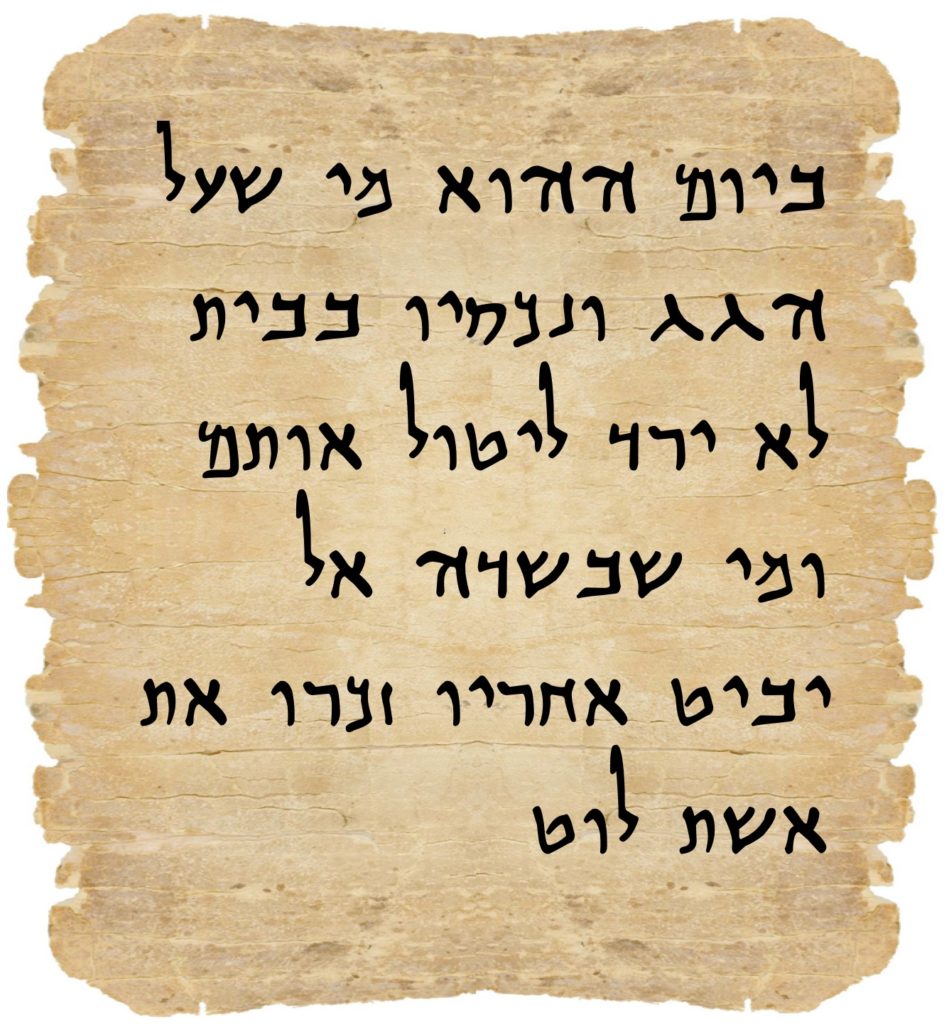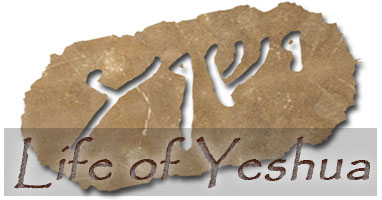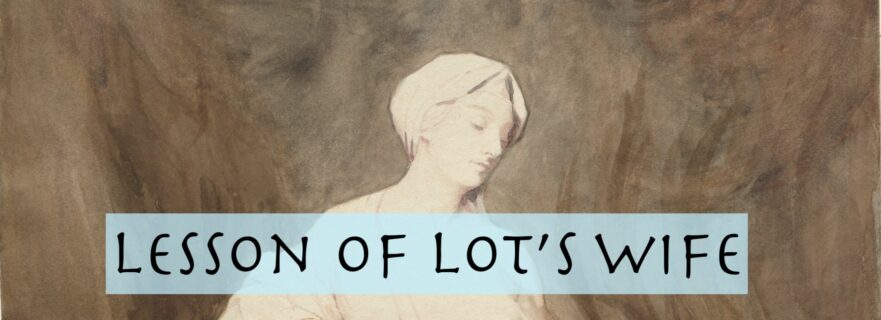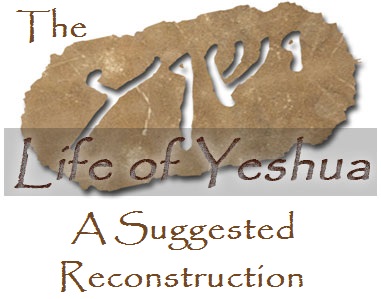(Matt. 24:17-18; Mark 13:15-16; Luke 17:31-32)
(Huck 184, 216; Aland 235, 290; Crook 286, 328)[41]
בַּיּוֹם הַהוּא מִי שֶׁעַל הַגָּג וּנְכָסָיו בַּבַּיִת לֹא יֵרֵד לִיטּוֹל אוֹתָם וּמִי שֶׁבַּשָּׂדֶה אַל יַבִּיט אַחֲרָיו זִכְרוּ אֶת אֵשֶׁת לוֹט
“On the day calamity strikes, a person on the roof whose belongings are inside should not go down to get them. Neither should a person outdoors look back—remember what happened to Lot’s wife![42]
| Table of Contents |
|
3. Conjectured Stages of Transmission 5. Comment 8. Conclusion |

.
Reconstruction
To view the reconstructed text of Lesson of Lot’s Wife click on the link below:
Premium Members and Friends of JP must be signed in to view this content.
If you are not a Premium Member or Friend, please consider registering. Prices start at $5/month if paid annually, with other options for monthly and quarterly and more: Sign Up For Premium
Conclusion
In Lesson of Lot’s Wife, Jesus warned his contemporaries that when the clash with the Roman Empire finally takes place, worrying about their possessions could come at the cost of their lives.
 Click here to return to The Life of Yeshua: A Suggested Reconstruction main page.
_______________________________________________________
Click here to return to The Life of Yeshua: A Suggested Reconstruction main page.
_______________________________________________________

- [1] Some scholars have maintained that the author of Luke extracted Lesson of Lot’s Wife from Mark’s eschatological discourse and inserted it after Days of the Son of Man. Cf., e.g., Bultmann, 117; Kloppenborg, 157-158; Nolland, Luke, 2:857; Catchpole, 248 n. 56; Bovon, 2:513. Others have supposed that Luke’s placement of Lesson of Lot’s Wife reflects the order of a pre-synoptic source (usually identified as “Q”). Cf., e.g., Manson, Sayings, 144-145; Knox, 1:113-114; Bundy, 390 §299. On the other hand, Fitzmyer (2:1165) argued for the original unity of Days of the Son of Man and Lesson of Lot’s Wife. ↩
- [2] In addition to the scholars mentioned in the previous footnote, see Beare, 187 §184. ↩
- [3] See Days of the Son of Man, under the subheading “Story Placement.” ↩
- [4] The author of Matthew changed “As it was in the days of Noah, so it will be in the days of the Son of Man” to “As were the days of Noah, so will be the coming of the Son of Man” (Matt. 24:37). See Days of the Son of Man, Comment to L10. The author of Luke changed “so it will be in the days of the Son of Man” to “it will be like that in the day the Son of Man is revealed” (Luke 17:30). See Days of the Son of Man, Comment to L32 and Comment to L33-35. ↩
- [5] See Marshall, 664; Bovon, 2:514. ↩
- [6] Cf. Marshall, 665; Gundry, Matt., 483. Pace Kloppenborg (158 n. 247), who denied any influence from a non-Markan source on Matthew’s version of Lesson of Lot’s Wife. ↩
- [7] In LXX the phrase ἐν ἐκείνῃ τῇ ἡμέρᾳ occurs as the translation of בַּיּוֹם הַהוּא in Exod. 32:28; Num. 6:11; 9:6; Deut. 31:22; Josh. 4:14; 14:9; 1 Chr. 29:22; 2 Chr. 15:11; Ps. 145[146]:4; Hos. 2:18, 20, 23; Amos 2:16; 8:3, 9; Mic. 5:9; Obad. 8; Zeph. 1:9, 10; Zech. 12:8; 14:6; Jer. 4:9; Ezek. 20:6; 24:26, 27; 45:22. ↩
- [8] See Sending the Twelve: Conduct in Town, Comment to L119-120. ↩
- [9] See Hatch-Redpath, 1:358. ↩
- [10] See Dos Santos, 34. ↩
- [11] See Shmuel Safrai, “Home and Family” (Safrai-Stern, 2:728-792, esp. 731-732). ↩
- [12] In each of the examples of housetop activities we have cited from rabbinic sources, the term for “roof” or “housetop” is גָּג. ↩
- [13] See Hatch-Redpath, 2:1269-1271. ↩
- [14] See Dos Santos, 93. ↩
- [15] Additional references to כֵּלִים in houses include:
נתחלפו לו כלים בבית האומן אינו רשיי לשתמש בהם
If his tools [כֵּלִים] were mixed up [with someone else’s] in the workshop, he is not authorized to use them. (t. Bab. Kam. 10:22; Vienna MS)
מעשה באחד ששכח כלים בבית הכנסת
An anecdote concerning a person who forgot items [כֵּלִים] in the synagogue.... (t. Toh. 8:10 [ed. Zuckermandel, 669])
- [16] See Dos Santos, 133. ↩
- [17] While Lot is not explicitly mentioned in the man-on-the-roof scenario, Lot had just been mentioned in Days of the Son of Man, and Lot’s wife is referenced in the man-in-the field scenario. ↩
- [18] On a positive view of Lot underlying Days of the Son of Man, see Days of the Son of Man, Comment to L33-35. A positive assessment of Lot’s character, however, was by no means unanimous in the ancient Jewish sources. Jubilees, for instance, expresses a sharply negative view of Lot (Jub. 16:7-9), while Philo viewed Lot as a mediocre man (Abr. §212). On differing views of Lot in ancient Jewish sources, see Erkki Koskenniemi, “‘Remember Lot’s Wife’: Gen 19:1-19 Rewritten,” in Rewritten Bible Reconsidered: Proceedings of the Conference in Karkku, Finland August 24-26 2006 (ed. Antti Laato and Jacques van Ruiten; Winona Lake, Ind.: Eisenbrauns, 2008), 125-147. ↩
- [19] The fact that Rabbi Eliezer ben Hyrcanus is the tradent of the Tosefta tradition concerning Lot only strengthens our supposition regarding the shared background of t. Sanh. 14:4 and Lesson of Lot’s Wife, since Rabbi Eliezer, who lived both before and after the destruction of the Second Temple, had a reputation for handing on traditions that he had received from earlier generations of the Second Temple period (cf. m. Avot 2:8). ↩
- [20] An alternative to the reconstructions discussed above is מַה שֶׁיֵּשׁ לוֹ (mah sheyēsh lō, “what that there is to him”). Examples of this type of expression also occur in rabbinic sources:
המלך תפס את העבד בידו והכניסו לבית גנזיו והראהו כלי כסף וכלי זהב אבני′ טובות ומרגליות וכל מה שיש לו בבית גנזיו ומאחר כן הוציאו והראהו אילנות גנים ופרדסים וקרפיפות וכל מה שיש לו בשדות
The king took the slave by the hand and brought him into the treasury and showed him items of silver and items of gold, gemstones and pearls, and all that he had [וְכָל מַה שֶׁיֵּשׁ לוֹ] in his treasury. And after that, he brought him out and showed him trees and gardens and parks and enclosures and all that he had [וְכָל מַה שֶׁיֵּשׁ לוֹ] in the fields. (Mechilta de-Rabbi Shimon ben Yochai, Shemot 3:8 [ed. Epstein-Melamed, 2])
כל שיש לי בבית הזה מסור בידך
All that I have [כָּל שֶׁיֵּשׁ לִי] in this house is given into your hand. (Avot de-Rabbi Natan, Version A, §1 [ed. Schechter, 6])
Nevertheless, our reconstruction of καὶ τὰ σκεύη αὐτοῦ (“and the belongings of him”) with וּנְכָסָיו (“and his property”) is closer to the Greek text of Luke 17:31. ↩
- [21] On the use of לֹא in MH to negate imperatives, see Segal, 223 §471. ↩
- [22] See Hatch-Redpath, 2:727-728. ↩
- [23] See Dos Santos, 85. ↩
- [24] Cf. Marshall, 665. ↩
- [25] See Hatch-Redpath, 1:34-36. ↩
- [26] On the form of the פ″נ infinitive in MH, see Segal, 78 §169. ↩
- [27] Cf. Marshall, 665. ↩
- [28] On ὁμοίως as an indicator of Lukan redaction, see Calamities in Yerushalayim, Comment to L13. ↩
- [29] Cf. Marshall, 665. ↩
- [30] In other words, the author of Mark could just as easily have written μὴ ἐπιστρεψάτω ἆραι τὸ ἱμάτιον αὐτοῦ (mē epistrepsatō arai to himation avtou, “let him not turn back to take his tunic”) with no appreciable loss of meaning. That this is the case is partially proven by Matthew’s version of Lesson of Lot’s Wife, in which εἰς τὰ ὀπίσω is shortened to ὀπίσω, which thereby reduces, but does not altogether eliminate, Mark’s superfluous phrase. ↩
- [31] See Hatch-Redpath, 1:531-534. ↩
- [32] There are also variant readings in 1 Kgdms. 16:7 (Alexandrinus) and Jonah 2:5 (Sinaiticus) where ἐπιστρέφειν occurs as the translation of הִבִּיט. ↩
- [33] On the other hand, in the writings of Philo we read this:
τήν γὰρ Λὼτ γυναῖκα ἐπιστραφεῖσαν εἰς τοὐπίσω φασίν οἱ χρησμοὶ γενέσθαι στήλην ἁλός
For the wife of Lot, turning back [ἐπιστραφεῖσαν] behind her—so say the oracles—became a pillar of salt. (Somn. 1:247)
Philo here used a participial form of the same verb, ἐπιστρέφειν, used in Lesson of Lot’s Wife. Does this suggest that Philo and the author (or translator) of Lesson of Lot’s Wife were acquainted with a LXX variant that read μὴ ἐπιστρέψῃς in Gen. 19:17 instead of μὴ περιβλέψῃς? ↩
- [34] Cf., e.g., Bultmann, 117; Nolland, Luke, 2:857; Bovon, 2:521; Wolter, 2:311. On the other hand, Gundry (Matt., 493) and Fitzmyer (2:1165) accepted the admonition to remember Lot’s wife as original to Luke’s source. ↩
- [35] See above, Comment to L3, where we observed similarities between the complex of ideas represented in t. Sanh. 14:4 and the Lukan versions of Days of the Son of Man, Lesson of Lot’s Wife and Preserving and Destroying, and Comment to L9, where we concluded that εἰς τὰ ὀπίσω in Mark 13:16 is a verbal relic of an earlier version of the pericope that contained an allusion to the story of Lot’s escape from Sodom. ↩
- [36] See Hatch-Redpath, 2:931. ↩
- [37] See Dos Santos, 54. ↩
- [38]
Lesson of Lot’s Wife Luke’s Version Anthology’s Wording (Reconstructed) ἐν ἐκείνῃ τῇ ἡμέρᾳ ὃς ἔσται ἐπὶ τοῦ δώματος καὶ τὰ σκεύη αὐτοῦ ἐν τῇ οἰκίᾳ μὴ καταβάτω ἆραι αὐτά καὶ ὁ ἐν ἀγρῷ ὁμοίως μὴ ἐπιστρεψάτω εἰς τὰ ὀπίσω μνημονεύετε τῆς γυναικὸς Λώτ ἐν ἐκείνῃ τῇ ἡμέρᾳ ὁ ἐπὶ τοῦ δώματος καὶ τὰ σκεύη αὐτοῦ ἐν τῇ οἰκίᾳ μὴ καταβάτω ἆραι αὐτά καὶ ὁ ἐν τῷ ἀγρῷ μὴ ἐπιστρεψάτω εἰς τὰ ὀπίσω μνημονεύετε τῆς γυναικὸς Λώτ Total Words: 34 Total Words: 33 Total Words Identical to Anth.: 31 Total Words Taken Over in Luke: 31 Percentage Identical to Anth.: 91.18% Percentage of Anth. Represented in Luke: 93.94% ↩
- [39]
Lesson of Lot’s Wife Mark’s Version Anthology’s Wording (Reconstructed) ὁ ἐπὶ τοῦ δώματος μὴ καταβάτω μηδὲ εἰσελθέτω τι ἆραι ἐκ τῆς οἰκίας αὐτοῦ καὶ ὁ εἰς τὸν ἀγρὸν μὴ ἐπιστρεψάτω εἰς τὰ ὀπίσω ἆραι τὸ ἱμάτιον αὐτοῦ ἐν ἐκείνῃ τῇ ἡμέρᾳ ὁ ἐπὶ τοῦ δώματος καὶ τὰ σκεύη αὐτοῦ ἐν τῇ οἰκίᾳ μὴ καταβάτω ἆραι αὐτά καὶ ὁ ἐν τῷ ἀγρῷ μὴ ἐπιστρεψάτω εἰς τὰ ὀπίσω μνημονεύετε τῆς γυναικὸς Λώτ Total Words: 28 Total Words: 33 Total Words Identical to Anth.: 15 Total Words Taken Over in Mark: 15 Percentage Identical to Anth.: 53.57% Percentage of Anth. Represented in Mark: 45.45% ↩
- [40]
Lesson of Lot’s Wife Matthew’s Version Anthology’s Wording (Reconstructed) ὁ ἐπὶ τοῦ δώματος μὴ καταβάτω ἆραι τὰ ἐκ τῆς οἰκίας αὐτοῦ καὶ ὁ ἐν τῷ ἀγρῷ μὴ ἐπιστρεψάτω ὀπίσω ἆραι τὸ ἱμάτιον αὐτοῦ ἐν ἐκείνῃ τῇ ἡμέρᾳ ὁ ἐπὶ τοῦ δώματος καὶ τὰ σκεύη αὐτοῦ ἐν τῇ οἰκίᾳ μὴ καταβάτω ἆραι αὐτά καὶ ὁ ἐν τῷ ἀγρῷ μὴ ἐπιστρεψάτω εἰς τὰ ὀπίσω μνημονεύετε τῆς γυναικὸς Λώτ Total Words: 24 Total Words: 33 Total Words Identical to Anth.: 17 Total Words Taken Over in Matt.: 17 Percentage Identical to Anth.: 70.83% Percentage of Anth. Represented in Matt.: 51.52% ↩
- [41] For abbreviations and bibliographical references, see “Introduction to ‘The Life of Yeshua: A Suggested Reconstruction.’” ↩
- [42] This translation is a dynamic rendition of our reconstruction of the conjectured Hebrew source that stands behind the Greek of the Synoptic Gospels. It is not a translation of the Greek text of a canonical source. ↩





